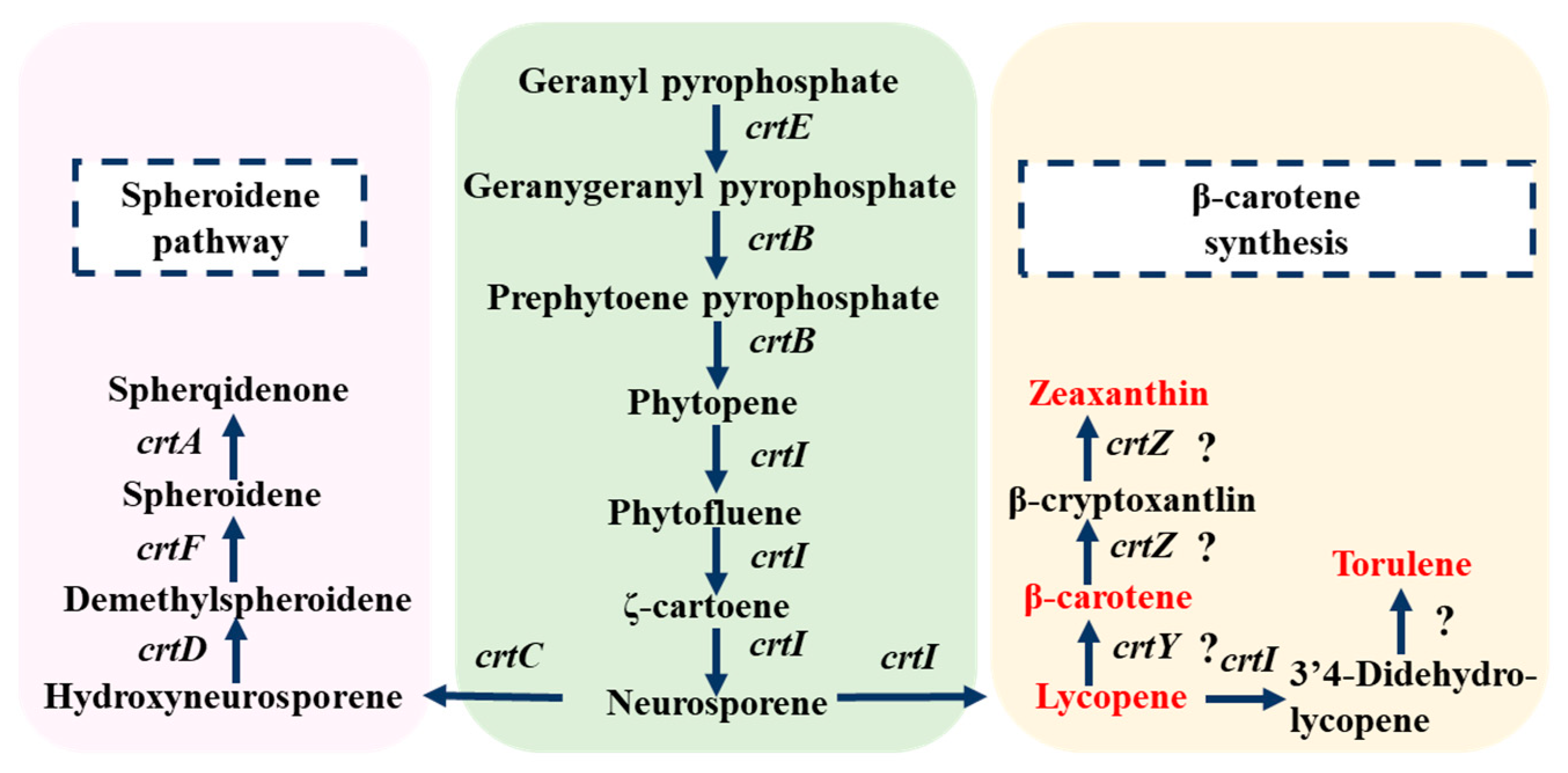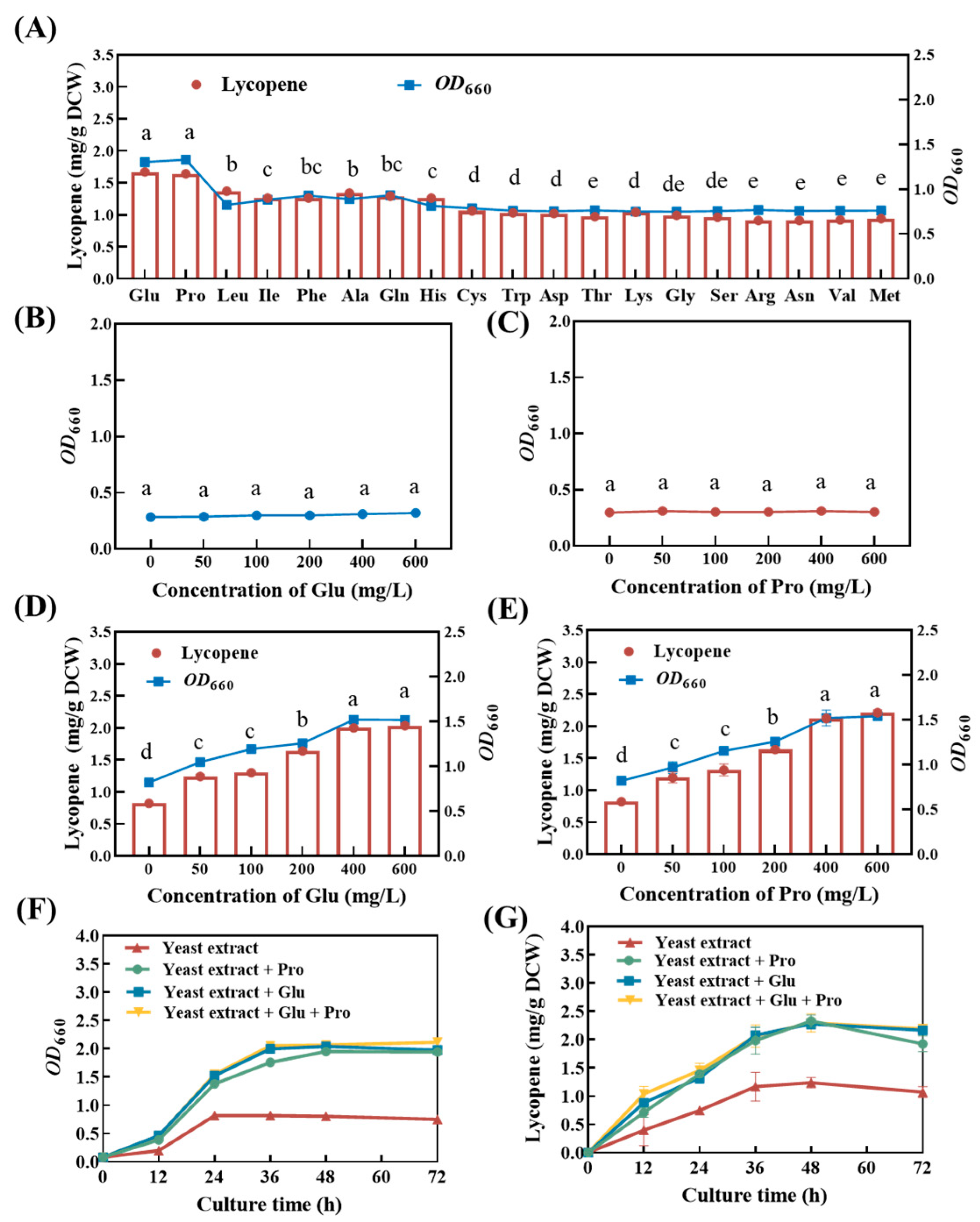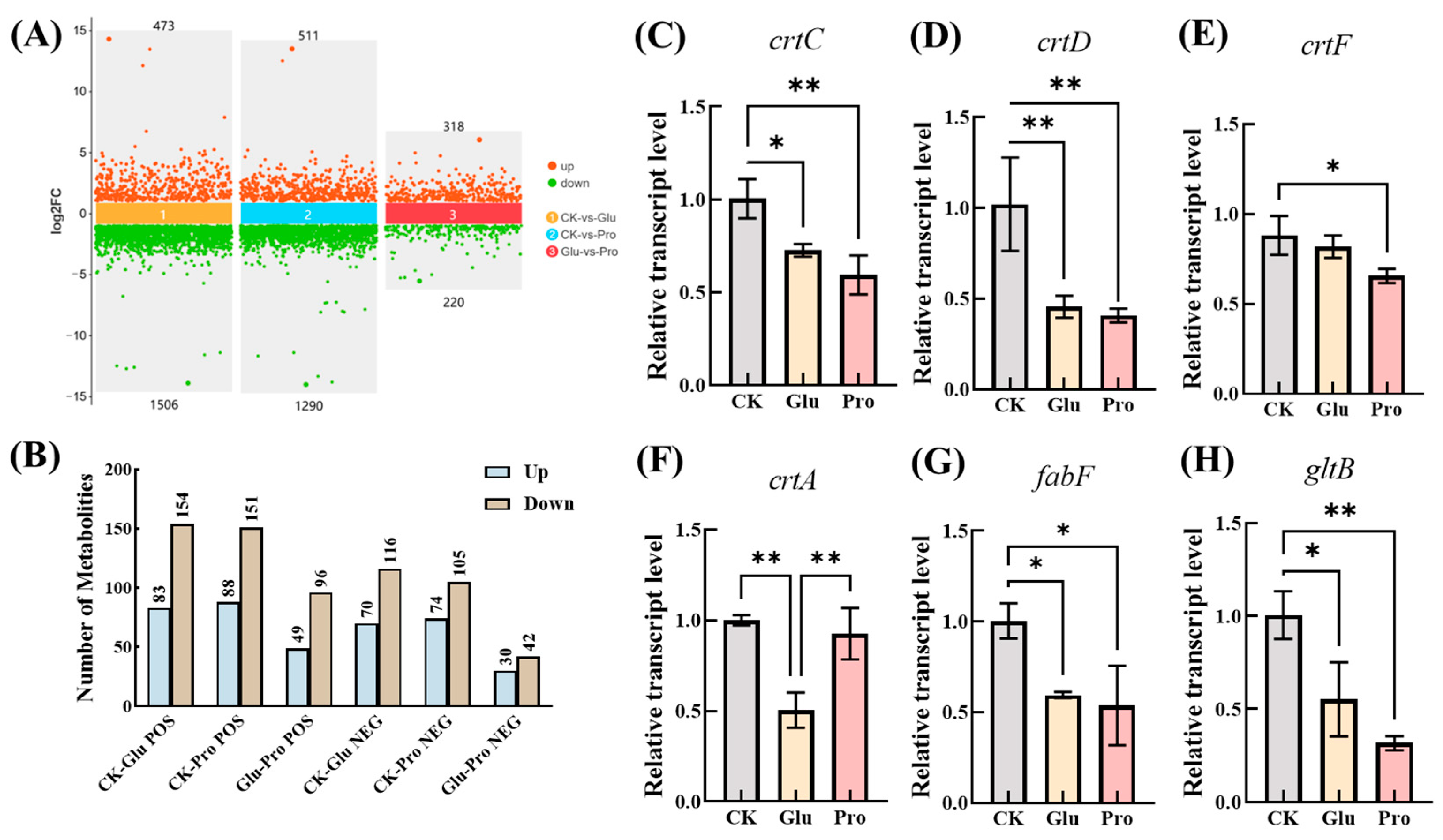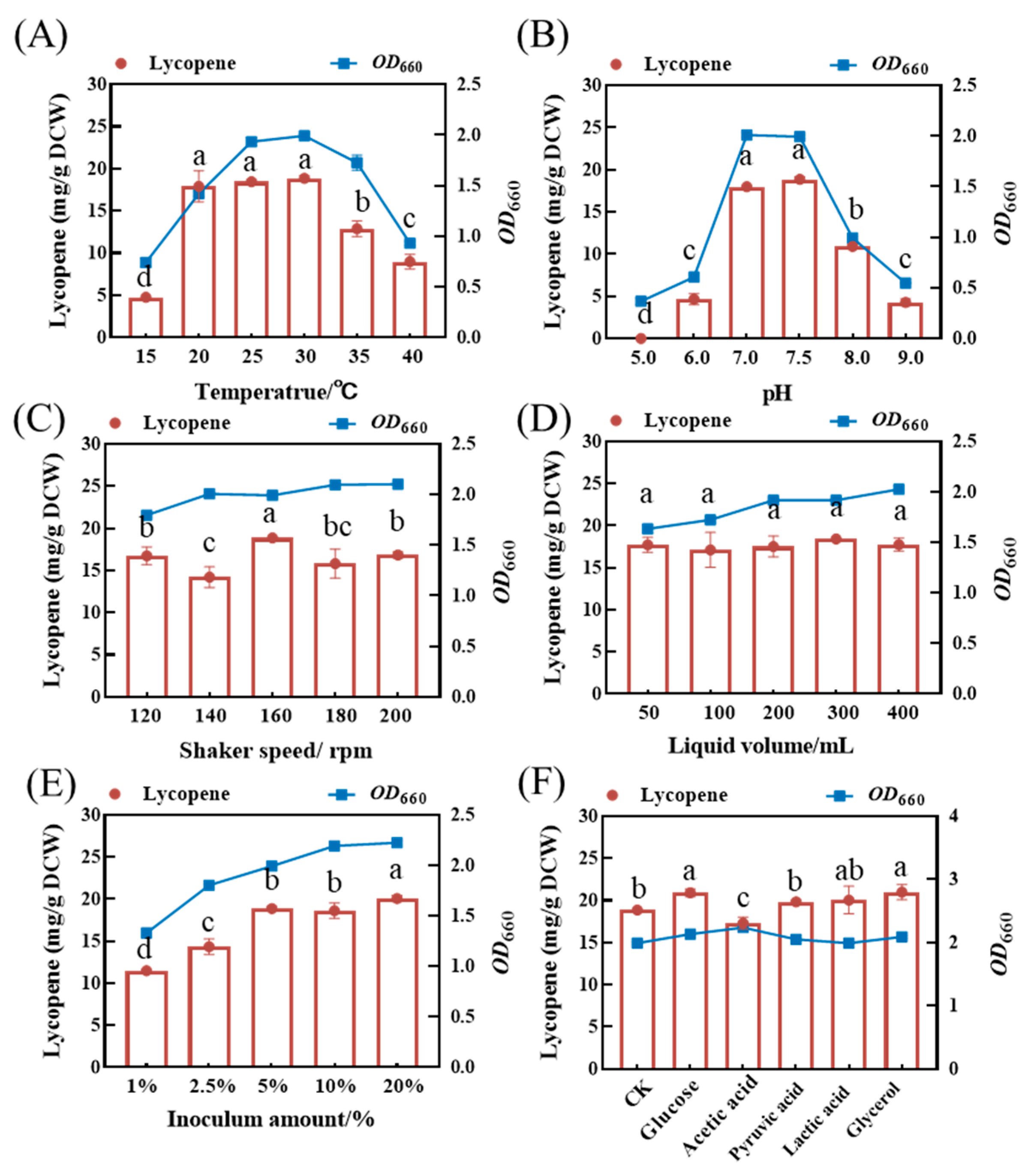Enhancing Lycopene Biosynthesis in Cereibacter sphaeroides DT.1: Effects of Glutamate and Proline Supplementation and Fermentation Optimization
Abstract
1. Introduction
2. Materials and Methods
2.1. Isolation and Identification of PNSB
2.2. Lycopene Accumulation Capacity in the PNSB Isolate
2.3. Transcriptomic and Metabolomic Analysis
2.4. Real-Time Quantitative PCR
2.5. Extraction of Lycopene and Measurement of Pigment Absorption Spectra
2.6. Quantitative Analysis of Lycopene
2.7. Gene Knockout of crtC
2.8. Optimization of Fermentative Conditions for Lycopene Production
2.9. Data Statistics and Analysis
3. Results
3.1. Isolation and Identification of PNSB Strain
3.2. Deduced Biosynthetic Pathway of Lycopene in Cereibacter sphaeroides DT.1
3.3. Conditions for Lycopene Accumulation in Cereibacter sphaeroides DT.1
3.4. Effects of Glutamate and Proline on Lycopene Accumulation
3.5. Mechanisms for Enhanced Lycopene Accumulation by Glutamate and Proline
3.6. Knocking Out of the crtC Gene Promotes the Accumulation of Lycopene
3.7. Optimization of Fermentative Conditions for Lycopene Production in ΔcrtC Mutant
3.8. Fed-Batch Fermentation for Lycopene Production
4. Discussion
5. Conclusions
Author Contributions
Funding
Institutional Review Board Statement
Informed Consent Statement
Data Availability Statement
Conflicts of Interest
Abbreviations
| PNSB | Purple nonsulfur bacteria |
| DCW | Dry cell weight |
| MEP pathway | Methylerythritol phosphate pathway |
| POS | Positive ion mode |
| NEG | Negative ion mode |
| MVA pathway | Mevalonate pathway |
| DMAPP | Dimethylallyl diphosphate |
| IPP | Isopentenyl diphosphate |
| GPP | Geranyl diphosphate |
| FPP | Farnesyl diphosphate |
| BChl a | Bacteriochlorophyll a |
| crtE | FPP/GGPP synthase, CrtE |
| crtB | Phytoene synthase, CrtB |
| crtI | Phytoene desaturase, CrtI |
| crtC | Acyclic carotenoid 1,2-hydratase, CrtC |
| crtD | FAD dependent oxidoreductase, CrtD |
| crtF | O-Methyltransferase family 2, CrtF |
| gltB | Glutamine synthetase, GltB |
| gltA | Citrate synthase, GltA |
| fabB | 3-oxoacyl-[acyl-carrier-protein] synthase I, FabB |
| fabF | 3-oxoacyl-[acyl-carrier-protein] synthase II, FabF |
| fabG | 3-oxoacyl-[acyl-carrier protein] reductase, FabG |
| fabI | Enoyl-[acyl-carrier protein] reductase I, FabI |
| fabZ | 3-hydroxyacyl-[acyl-carrier-protein] dehydratase, FabZ |
| putA | Proline utilization A, PutA |
| acnA | Aconitate hydratase, AcnA |
| dxs | 1-deoxy-D-xylulose-5-phosphate synthase, Dxs |
| ispD | 2-C-methyl-D-erythritol 4-phosphate cytidylyltransferase, IspD |
| PpsR | Transcriptional regulator PpsR |
| PrrA | Transcription factor PrrA |
| Mvd | Pyrophospomevalonate decarboxylase |
| Pmk | Phosphomevalonate kinase |
| P5CR | Pyrroline-5-carboxylate reductase |
| PRODH | Proline dehydrogenase |
| P5CDH | Delta-1-pyrroline-5-carboxylate dehydrogenase |
References
- Zhu, J.; Hu, Q.; Shen, S. Enhanced antitumor efficacy and attenuated cardiotoxicity of doxorubicin in combination with lycopene liposomes. J. Liposome Res. 2020, 30, 37–44. [Google Scholar] [CrossRef]
- Zhang, J.; Sun, H.; Guo, S.; Ren, Y.; Li, M.; Wang, J.; Zhang, H.; Gong, G.; Xu, Y. Decreased protein abundance of lycopene β-cyclase contributes to red flesh in domesticated watermelon. Plant Physiol. 2020, 183, 1171–1183. [Google Scholar] [PubMed]
- Pasupuleti, V.; Kulkarni, S.G. Lycopene fortification on the quality characteristics of beverage formulations developed from pink flesh guava (Psidium guajava L.). J. Food Sci. Technol. 2014, 5, 4126–4131. [Google Scholar]
- Khan, U.M.; Sevindik, M.; Zarrabi, A.; Nami, M.; Ozdemir, B.; Kaplan, D.N.; Selamoglu, Z.; Hasan, M.; Kumar, M.; Alshehri, M.M.; et al. Lycopene: Food sources, biological activities, and human health benefits. Oxidative Med. Cell. Longev. 2021, 2021, 2713511. [Google Scholar]
- Chernyshova, M.P.; Pristenskiy, D.V.; Lozbiakova, M.V.; Chalyk, N.E.; Bandaletova, T.Y.; Petyaev, I.M. Systemic and skin-targeting beneficial effects of lycopene-enriched ice cream: A pilot study. J. Dairy Sci. 2019, 102, 14–25. [Google Scholar] [PubMed]
- Wang, Y.H.; Zhang, R.R.; Yin, Y.; Tan, G.F.; Wang, G.L.; Liu, H.; Zhuang, J.; Zhang, J.; Zhuang, F.Y.; Xiong, A.S. Advances in engineering the production of the natural red pigment lycopene: A systematic review from a biotechnology perspective. J. Adv. Res. 2023, 46, 31–47. [Google Scholar] [PubMed]
- Li, Y.; Cui, Z.; Hu, L. Recent technological strategies for enhancing the stability of lycopene in processing and production. Food Chem. 2023, 30 Pt A, 134799. [Google Scholar]
- Wang, Q.; Chen, Y.; Yang, Q.; Zhao, J.; Feng, L.; Wang, M. SR5AL serves as a key regulatory gene in lycopene biosynthesis by Blakeslea trispora. Microb. Cell Factories 2022, 21, 126. [Google Scholar]
- Xu, J.; Xu, X.; Xu, Q.; Zhang, Z.; Jiang, L.; Huang, H. Efficient production of lycopene by engineered E. coli strains harboring different types of plasmids. Bioprocess Biosyst. Eng. 2018, 41, 489–499. [Google Scholar]
- Su, A.; Chi, S.; Li, Y.; Tan, S.; Qiang, S.; Chen, Z.; Meng, Y. Metabolic redesign of Rhodobacter sphaeroides for lycopene production. J. Agric. Food Chem. 2018, 66, 5879–5885. [Google Scholar]
- Wang, G.S.; Grammel, H.; Abou-Aisha, K.; Sägesser, R.; Ghosh, R. High-level production of the industrial product lycopene by the photosynthetic bacterium Rhodospirillum rubrum. Appl. Environ. Microbiol. 2012, 78, 7205–7215. [Google Scholar] [CrossRef] [PubMed]
- Tuly, J.A.; Zabed, H.M.; Nizami, A.S.; Mehedi Hassan, M.; Roknul Azam, S.M.; Kumar Awasthi, M.; Janet, Q.; Chen, G.; Dzidzorgbe Kwaku Akpabli-Tsigbe, N.; Ma, H. Bioconversion of agro-food industrial wastes into value-added peptides by a Bacillus sp. Mutant through solid-state fermentation. Bioresour. Technol. 2022, 346, 126513. [Google Scholar] [CrossRef]
- Li, M.; Xia, Q.; Lv, S.; Tong, J.; Wang, Z.; Nie, Q.; Yang, J. Enhanced CO2 capture for photosynthetic lycopene production in engineered Rhodopseudomonas palustris, a purple non-sulfur bacterium. Green Chem. 2022, 24, 7500–7518. [Google Scholar] [CrossRef]
- Qu, Y.; Su, A.; Li, Y.; Meng, Y.; Chen, Z. Manipulation of the regulatory genes ppsR and prrA in Rhodobacter sphaeroides enhances lycopene production. J. Agric. Food Chem. 2021, 69, 4134–4143. [Google Scholar] [CrossRef] [PubMed]
- Concepcion, M.R.; Avalos, J.; Luisa Bonet, M.; Boronat, A.; Gomez-Gomez, L.; Hornero-Mendez, D. A global perspective on carotenoids: Metabolism, biotechnology, and benefits for nutrition and health. Prog. Lipid Res. 2018, 70, 62–93. [Google Scholar] [CrossRef] [PubMed]
- Li, C.; Swofford, C.A.; Sinskey, A.J. Modular engineering for microbial production of carotenoids. Metab. Eng. Commun. 2019, 15, e00118. [Google Scholar] [CrossRef]
- Ye, V.M.; Bhatia, S.K. Pathway engineering strategies for production of beneficial carotenoids in microbial hosts. Biotechnol. Lett. 2012, 34, 1405–1414. [Google Scholar] [CrossRef]
- Iwasaka, H.; Koyanagi, R.; Satoh, R.; Nagano, A.; Watanabe, K.; Hisata, K.; Satoh, N.; Aki, T. A possible trifunctional β-carotene synthase gene identified in the draft genome of Aurantiochytrium sp. Strain KH105. Genes 2018, 9, 200. [Google Scholar] [CrossRef]
- Shimizu, T.; Teramoto, H.; Inui, M. Introduction of glyoxylate bypass increases hydrogen gas yield from acetate and l-glutamate in Rhodobacter sphaeroides. Appl. Environ. Microbiol. 2019, 85, e01873-18. [Google Scholar] [CrossRef]
- Koga, A.; Yamasaki, T.; Hayashi, S.; Yamamoto, S.; Miyasaka, H. Isolation of purple nonsulfur bacteria from the digestive tract of ayu (Plecoglossus altivelis). Biosci. Biotechnol. Biochem. 2022, 24, 407–412. [Google Scholar] [CrossRef]
- Caetano-Lopes, J.; Rodrigues, A.; Lopes, A.; Vale, A.C.; Pitts-Kiefer, M.A.; Vidal, B.; Perpétuo, I.P.; Monteiro, J.; Konttinen, Y.T.; Vaz, M.F.; et al. Rheumatoid arthritis bone fragility is associated with upregulation of il17 and dkk1 gene expression. Clin. Rev. Allergy Immunol. 2014, 47, 38–45. [Google Scholar] [CrossRef] [PubMed]
- Zuorro, A. Enhanced lycopene extraction from tomato peels by optimized mixed-polarity solvent mixtures. Molecules 2020, 25, 2038. [Google Scholar] [CrossRef] [PubMed]
- Sun, L.; Wang, J.; Jiang, W.; Li, Y.; Zhang, L.; Ding, Z.; Gu, Z.; Shi, G.; Xu, S. Construction of a highly efficient synthetic lycopene engineered Saccharomyces cerevisiae. Sheng Wu Gong Cheng Xue Bao 2020, 36, 1334–1345. [Google Scholar]
- Yoon, S.H.; Ha, S.M.; Lim, J.; Kwon, S.; Chun, J. A large-scale evaluation of algorithms to calculate average nucleotide identity. Antonie Leeuwenhoek 2017, 110, 1281–1286. [Google Scholar] [CrossRef] [PubMed]
- Oren, A.; Garrity, G.M. List of new names and new combinations previously effectively, but not validly, published. Int. J. Syst. Evol. Microbiol. 2020, 70, 2960–2966. [Google Scholar]
- Shi, B.; Ma, T.; Ye, Z.; Li, X.; Huang, Y.; Zhou, Z.; Ding, Y.; Deng, Z.; Liu, T. Systematic metabolic engineering of Saccharomyces cerevisiae for lycopene overproduction. J. Agric. Food Chem. 2019, 67, 11148–11157. [Google Scholar]
- Hunter, C.N.; Hundle, B.S.; Hearst, J.E.; Lang, H.P.; Gardiner, A.T.; Takaichi, S.; Cogdell, R.J. Introduction of new carotenoids into the bacterial photosynthetic apparatus by combining the carotenoid biosynthetic pathways of Erwinia herbicola and Rhodobacter sphaeroides. J. Bacteriol. 1994, 176, 3692–3697. [Google Scholar]
- Martínez-Reyes, I.; Chandel, N.S. Mitochondrial TCA cycle metabolites control physiology and disease. Nat. Commun. 2020, 11, 102. [Google Scholar]
- Mullen, A.R.; Wheaton, W.W.; Jin, E.S.; Chen, P.H.; Sullivan, L.B.; Cheng, T.; Yang, Y.; Linehan, W.M.; Chandel, N.S.; DeBerardinis, R.J. Reductive carboxylation supports growth in tumor cells with defective mitochondria. Nature 2011, 481, 385–388. [Google Scholar]
- Fournié, M.; Truan, G. Multiplicity of carotene patterns derives from competition between phytoene desaturase diversification and biological environments. Sci. Rep. 2020, 10, 21106. [Google Scholar]
- Steiger, S.; Astier, C.; Sandmann, G. Substrate specificity of the expressed carotenoid 3,4-desaturase from Rubrivivax gelatinosus reveals the detailed reaction sequence to spheroidene and spirilloxanthin. Biochem. J. 2000, 349, 635–640. [Google Scholar] [PubMed]
- Choi, B.H.; Kim, S.H.; Lee, P.C. Hot spots of phytoene desaturase from Rhodobacter sphaeroides influencing the desaturation of phytoene. Catalysts 2021, 11, 1248. [Google Scholar] [CrossRef]
- Choi, S.; Seo, B.; Lim, K.; Nam, S.W.; Kim, G. Molecular cloning and overexpression of phytoene desaturase (CrtI) from Paracoccus haeundaensis. Microbiol. Biotechnol. Lett. 2018. 46, 145–153.
- Schaub, P.; Yu, Q.; Gemmecker, S.; Poussin-Courmontagne, P.; Mailliot, J.; McEwen, A.G.; Ghisla, S.; Al-Babili, S.; Cavarelli, J.; Beyer, P. On the structure and function of the phytoene desaturase CrtI from Pantoea ananatis, a membrane-peripheral and FAD-dependent oxidase/isomerase. PLoS ONE 2012, 7, e39550. [Google Scholar]
- Zhang, J.; Lu, L.; Yin, L.; Xie, S.; Xiao, M. Carotenogenesis gene cluster and phytoene desaturase catalyzing both three- and four-step desaturations from Rhodobacter azotoformans. FEMS Microbiol. Lett. 2012, 333, 138–145. [Google Scholar]
- Wang, L.; Song, L.; He, X.; Teng, F.; Hu, M.; Tao, Y. Production of isofloridoside from galactose and glycerol using α-galactosidase from Alicyclobacillus hesperidum. Enzym. Microb. Technol. 2020, 134, 109480. [Google Scholar]
- Zhu, J.; Schwörer, S.; Berisa, M.; Kyung, Y.J.; Ryu, K.W.; Yi, J.; Jiang, X.; Cross, J.R.; Thompson, C.B. Mitochondrial NADP(H) generation is essential for proline biosynthesis. Science 2021, 372, 968–972. [Google Scholar] [PubMed]
- Ye, P.; Li, X.; Cui, B.; Song, S.; Shen, F.; Chen, X.; Wang, G.; Zhou, X.; Deng, Y. Proline utilization A controls bacterial pathogenicity by sensing its substrate and cofactors. Commun. Biol. 2022, 5, 496. [Google Scholar]
- Imam, S.; Noguera, D.R.; Donohue, T.J. Global analysis of photosynthesis transcriptional regulatory networks. PLoS Genet. 2014, 10, e1004837. [Google Scholar]
- Imam, S.; Noguera, D.R.; Donohue, T.J. An integrated approach to reconstructing genome-scale transcriptional regulatory networks. PLoS Comput. Biol. 2015, 11, e1004103. [Google Scholar]
- Sun, T.; Miao, L.; Li, Q.; Dai, G.; Lu, F.; Liu, T. Production of lycopene by metabolically-engineered Escherichia coli. Biotechnol. Lett. 2014, 36, 1515–1522. [Google Scholar] [PubMed]
- Xu, Y.; Liu, K.; Han, Y.; Xing, Y.; Zhang, Y.; Yang, Q.; Zhou, M. Codon usage bias regulates gene expression and protein conformation in yeast expression system P. pastoris. Microb. Cell Factories 2021, 20, 91. [Google Scholar]
- Keasling, J.D. Manufacturing molecules through metabolic engineering. Science 2010, 330, 1355–1358. [Google Scholar] [PubMed]








| Primer Name | Nucleotide Sequence (5′-3′) |
|---|---|
| crtC F | TGACGCTCAAGGACGATGGC |
| crtC R | CCAGGTCCAGAAACGGAAGTCG |
| crtD F | AATCGAGGGCGGGATGCA |
| crtD R | TCGCCGTTGAAGACGATGTGA |
| crtF F | GTCGCGGGCTTCGTCCATT |
| crtF R | GGCTCGGTCTCGCCTTTCA |
| crtA F | ACCAAGATGGCCGACGAGA |
| crtA R | AGAAGGTAACCTGCTGGACGAA |
| fabF F | TGGATGGAGCCCAAGGACAG |
| fabF R | GGATGAAGAAGGGCGAGACG |
| gltB F | GGCTCTACCTCTGCTCGCTGTC |
| gltB R | GCGGATCTCGTGGCTCTTCA |
| Primer Name | Nucleotide Sequence (5′-3′) |
|---|---|
| crtC U-F | GGGGGATCCACTAGTTCTAGATTCGGACCGATCGCCGCA |
| crtC U-R | ATCGTCGTCGGACACGCCGT |
| crtC D-F | ACGGCGTGTCCGACGACGATCCCGGCCGCCGCCGGCC |
| crtC D-R | AGGGAACAAAAGCTGGAGCTCCACGCTCTGGACGCCGGT |
| crtC F | GTGATCGGCTTCATCGGCTCGGTCTTCTCGCCCTG |
| crtC R | GGCGAGCGGAAGCGGCGCAGATCGAG |
| M13F | TGTAAAACGACGGCCAGT |
| M13R | AGCGGATAACAATTTCACACAGGA |
| Characteristics | Data |
|---|---|
| Genome size/bp | 4,364,336 |
| Total number | 4257 |
| Total length/bp | 3,866,193 |
| Average length/bp | 908.20 |
| Chromosome/bp | 3,154,711 |
| Plasmid1/bp | 908,038 |
| Plasmid2/bp | 200,903 |
| Plasmid3/bp | 100,684 |
| GC content/% | 69.35 |
| Length/genome length/% | 88.59 |
| Index | MS2_Name | RT/min | CK | Glu | Pro |
|---|---|---|---|---|---|
| M537T173_POS | Beta-carotene | 2.88 | 7781.43 ± 2634.71 | 14,439.83 ± 1235.09 | 15,336.38 ± 3178.37 |
| M569T184_POS | Zeaxanthin | 3.07 | 963,075.70 ± 142,406.20 | 926,266.30 ± 341,863.26 | 776,124.00 ± 3178.37 |
| M569T206_POS | Lutein | 3.43 | 1,160,456.61 ± 65,581.64 | 919,355.83 ± 362,079.99 | 653,686.38 ± 35,581.47 |
| M619T231_POS | Canthaxanthin | 3.02 | 6857.63 ± 757.37 | 18,838.77 ± 1054.73 | 7727.39 ± 632.04 |
| M619T231_POS | Astaxanthin | 3.85 | 2039.10 ± 321.32 | 2957.82 ± 453.69 | 2380.18 ± 832.02 |
| M582T33_POS | Spheroidenone | 0.55 | 21,182.96 ± 9215.70 | 175,102.50 ± 24,123.34 | 458,504.69 ± 256,812.61 |
| M535T173_POS | Torulene | 2.89 | 11,520.06 ± 1701.78 | 40,305.76 ± 19,795.78 | 23,530.64 ± 7258.71 |
| M313T443_NEG | GPP | 7.38 | 23,260.55 ± 3630.39 | 152,115.30 ± 8159.49 * | 330,939.50 ± 10,876.51 * |
| M381T318_NEG | FPP | 5.30 | 19,575.74 ± 1199.62 | 5487.88 ± 677.15 | 4712.32 ± 1371.83 |
| Medium Composition | Anaerobic | Aerobic | ||
|---|---|---|---|---|
| OD660 | Lycopene (mg/g DCW) | OD660 | Lycopene (mg/g DCW) | |
| Yeast extract + peptone | 2.26 ± 0.09 a | <0.10 | 1.61 ± 0.04 a | 1.55 ± 0.27 a |
| Yeast extract | 1.82 ± 0.04 c | <0.10 | 0.79 ± 0.04 b | 0.82 ± 0.49 a |
| Peptone | 1.77 ± 0.02 b | <0.10 | 0.34 ± 0.02 c | <0.10 |
Disclaimer/Publisher’s Note: The statements, opinions and data contained in all publications are solely those of the individual author(s) and contributor(s) and not of MDPI and/or the editor(s). MDPI and/or the editor(s) disclaim responsibility for any injury to people or property resulting from any ideas, methods, instructions or products referred to in the content. |
© 2025 by the authors. Licensee MDPI, Basel, Switzerland. This article is an open access article distributed under the terms and conditions of the Creative Commons Attribution (CC BY) license (https://creativecommons.org/licenses/by/4.0/).
Share and Cite
Zhang, Y.; Ma, X.; Xu, Z.; Gu, X.; Gu, X. Enhancing Lycopene Biosynthesis in Cereibacter sphaeroides DT.1: Effects of Glutamate and Proline Supplementation and Fermentation Optimization. Fermentation 2025, 11, 168. https://doi.org/10.3390/fermentation11040168
Zhang Y, Ma X, Xu Z, Gu X, Gu X. Enhancing Lycopene Biosynthesis in Cereibacter sphaeroides DT.1: Effects of Glutamate and Proline Supplementation and Fermentation Optimization. Fermentation. 2025; 11(4):168. https://doi.org/10.3390/fermentation11040168
Chicago/Turabian StyleZhang, Yiyan, Xiongyao Ma, Zhe Xu, Xiangyu Gu, and Xiangyang Gu. 2025. "Enhancing Lycopene Biosynthesis in Cereibacter sphaeroides DT.1: Effects of Glutamate and Proline Supplementation and Fermentation Optimization" Fermentation 11, no. 4: 168. https://doi.org/10.3390/fermentation11040168
APA StyleZhang, Y., Ma, X., Xu, Z., Gu, X., & Gu, X. (2025). Enhancing Lycopene Biosynthesis in Cereibacter sphaeroides DT.1: Effects of Glutamate and Proline Supplementation and Fermentation Optimization. Fermentation, 11(4), 168. https://doi.org/10.3390/fermentation11040168






